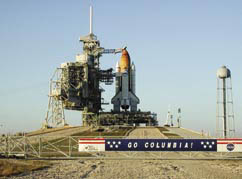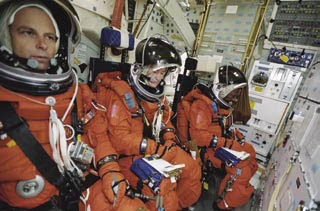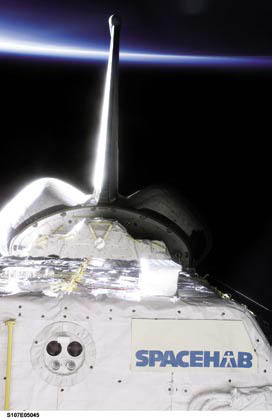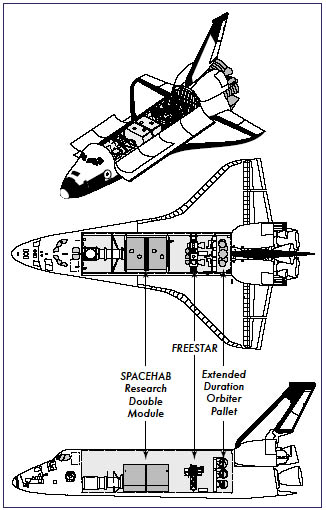2.1 MISSION OBJECTIVES AND THEIR RATIONALES
2.1 Mission Objectives and Their Rationales
― ミッションの目的とその根拠 ―
― ミッションの目的とその根拠 ―
Throughout the 1990s, NASA flew a number of dedicated science missions, usually aboard Columbia because it was equipped for extended-duration missions and was not being used for Shuttle-Mir docking missions or the assembly of the International Space Station. On many of these missions, Columbia carried pressurized Spacelab or SPACEHAB modules that extended the habitable experiment space available and were intended as facilities for life sciences and microgravity research.
1990年代を通じてNASAはいくつもの科学ミッションを行ってきましたが、その多くはコロンビアによるものでした。なぜなら、コロンビアには長期滞在用の機材が搭載されていましたし、シャトル-ミールドッキングミッションや国際宇宙ステーションの組立には使用されていなかったからです。これらのミッションの多くで、コロンビアは、宇宙での生活を広げるための実験や、生命科学や微小重力実験を行うことを目的とした与圧されたスペースラブ(Spacelab)もしくはスペースハブ(SPACEHAB)モジュールを搭載していました。
In June 1997, the Flight Assignment Working Group at Johnson Space Center in Houston designated STS-107, tentatively scheduled for launch in the third quarter of Fiscal Year 2000, a "research module" flight. In July 1997, several committees of the National Academy of Sciences Space Studies Board sent a letter to NASA Administrator Daniel Goldin recommend-ing that NASA dedicate several future Shuttle missions to microgravity and life sciences. The purpose would be to train scientists to take full advantage of the International Space Stations research capabilities once it became operational, and to reduce the gap between the last planned Shuttle science mission and the start of science research aboard the Space Station.*1 In March 1998, Goldin announced that STS-107, tentatively scheduled for launch in May 2000, would be a multi-disciplinary science mission modeled after STS-90, the Neurolab mission scheduled later in 1998.*2 In October 1998, the Veterans Affairs and Housing and Urban Development and Independent Agencies Appropriations Conference Re-port expressed Congress concern about the lack of Shuttle-based science missions in Fiscal Year 1999, and added $15 million to NASAs budget for STS-107. The following year the Conference Report reserved $40 million for a second sci-ence mission. NASA cancelled the second science mission in October 2002 and used the money for STS-107.
1997年6月に、ジョンソン宇宙センターのフライト・アサインメント・ワーキング・グループは、STS-107の選定を行いました。「リサーチモジュール」を利用するフライトで、打上げの仮スケジュールは2000年の第3四半期に定められました。1997年には、科学アカデミーのスペースシャトル委員会は、NASAの理事ダニエル・ゴールディンに書簡を送り、NASAが将来的にシャトルのミッションの幾つかを微小重力実験と生命科学に当てるべきだと勧告しました。これは、国際宇宙ステーションが実用段階に入ったときに、科学者がその能力を100%生かすための訓練を行うこと、そして、宇宙ステーションで始められる科学実験とスペースシャトルで計画されている科学ミッションとのギャップを減らすことが目的でした。1998年3月、ゴールディンはSTS-107を発表し、打上げを2000年の5月と発表しました。1998年の後半、STS-90のニューロラブ(Nurolab)以後、一般的になった複数の学問領域に渡る科学ミッションです。1998年10月、退役軍人局および都市住宅整備公団による独立委員会歳出会議のレポートにおいて、議会がシャトルによる科学ミッションが1999年度に行われていないことを考慮し、STS-107のために、NASAの予算を1500万ドル追加することを検討していることが発表されました。翌年の会議では、次の科学ミッションのためにさらに4000万ドルが追加されましたが、NASAが、2002年10月に2番目の科学ミッションをキャンセルしたため、この予算がSTS-107に使われることになりました。
In addition to a variety of U.S. experiments assigned to STS-107, a joint U.S./Israeli space experiment ュ the Medi-terranean-Israeli Dust Experiment, or MEIDEX ュ was added to STS-107 to be accompanied by an Israeli astronaut as part of an international cooperative effort aboard the Shuttle similar to those NASA had begun in the early 1980s. Triana, a deployable Earth-observing satellite, was also added to the mission to save NASA from having to buy a commercial launch to place the satellite in orbit. Political disagreements between Congress and the White House delayed Triana, and the satellite was replaced by the Fast Reaction Experiments Enabling Science, Technology, Applications, and Research (FREESTAR) payload, which was mounted behind the SPACEHAB Research Double Module.*3
STS-107でアメリカが行った実験のバラエティについて付け加えるならば、アメリカとイスラエルの共同宇宙実験―地中海-イスラエル・ダスト実験、あるいはMEIDEXと呼ばれる実験が、イスラエルの宇宙飛行士の搭乗に伴って行われたことがあげられるでしょう。この宇宙飛行士の搭乗は、NASAが1980年代の初めから行っている国際協力のためのシャトル搭乗の一環として行われたものです。また、衛星を軌道に乗せるために商業打上げに頼るのを避けるために、トリアナ地球観測衛星の投入もミッションに加えられました。しかし、ホワイトハウスと議会の政治的な意見の不一致からトリアナ衛星は遅れ、代わりにSPACEHAB研究用ダブルモジュールの後ろに「科学、テクノロジー、応用と調査を可能にする高速反応実験装置(FREESTER:Fast Reaction Experiments Enabling Science, Technology, Applications, and Research:)」が搭載されることになりました。
Schedule Slippage
スケジュールの遅れ
STS-107 was finally scheduled for launch on January 11, 2001. After 13 delays over two years, due mainly to other missions taking priority, Columbia was launched on January 16, 2003 (see Figure 2.1-1). Delays may take several forms. When any delay is mentioned, most people think of a Space Shuttle sitting on the launch pad waiting for launch. But most delays actually occur long before the Shuttle is configured for a mission. This was the case for STS-107 ュ of the 13 delays, only a few occurred after the Orbiter was configured for flight; most happened earlier in the planning process. Three specific events caused delays for STS-107:
STS-107は最終的に2001年1月11日に打ち上げられることが決まりました。しかし、その後、2年間に渡って13回の延期が行われ―殆どの場合が他のミッションを優先したためです―コロンビアは2003年1月16日に打ち上げられました(図2-1-1)。「延期」には幾つか種類があります。打上げの延期について語られる場合、多くの人々がシャトルが発射台の上に乗っているところを思い描きますが、実際は殆どの延期が、シャトルをミッションのために組み立てるずっと前に起きるのです。STS-107の13回の延期は、殆どのがプランニングの初期段階で起こり、オービターが組み立てられてからはほとんどありませんでした。STS-107の延期の主要な原因は以下の通りです。
- Removal of Triana: This Earth-observing satellite was replaced with the FREESTAR payload.
- Orbiter Maintenance Down Period: Columbias depot-level maintenance took six months longer than originally planned, primarily to correct problems encountered with Kapton wiring (see Chapter 4). This resulted in the STS-109 Hubble Space Telescope service mission being launched before STS-107 because it was considered more urgent.
- Flowliner cracks: About one month before the planned July 19, 2002 launch date for STS-107, concerns about cracks in the Space Shuttle Main Engine propellant system flowliners caused a four-month grounding of the Orbiter fleet. (The flowliner, which is in the main propellant feed lines, mitigates turbulence across the flexible bellows to smooth the flow of propellant into the main engine low-pressure turbopump. It also protects the bellows from flow-induced vibration.) First discovered on Atlantis, the cracks were eventually discovered on each Orbiter; they were fixed by welding and polishing. The grounding delayed the exchange of the Expedition 5 International Space Station crew with the Expedition 6 crew, which was scheduled for STS-113. To maintain the International Space Sta-tion assembly sequence while minimizing the delay in returning the Expedition 5 crew, both STS-112 and STS-113 were launched before STS-107.
- トリアナ衛星の除外: この地球探査衛星は、FREESTARに置き換えられました。
- オービターのメンテナンスの遅れ:コロンビアの格納庫レベルでのメンテナンスが予定より6ヶ月余計にかかりました。これはカプトン(Kapton)の配線の問題を修正するためです(これについては第4章を参照してください)。この遅れにより、ハッブル宇宙望遠鏡のサービスミッションを行うSTS-109がより緊急と判断され、STS-107より先に打ち上げられることになりました。
- フローライナー(Flowliner)の亀裂:2002年7月19日に予定されていたSTS-107の打ち上げの一ヶ月前、スペースシャトル主エンジン燃料システムのフローライナーに発生した亀裂を考慮したもの。これは、シャトルの4ヶ月間の飛行停止を引き起こすことになりました。(フローライナーというのは、燃料供給のための主パイプにあり、自在に曲がるベローズ(蛇腹)を通った燃料の乱れを押さえて、メインエンジンの低圧ターボポンプへスムーズに燃料を流すためのものです。また、燃料の流れが引き起こす振動からベローズを守る役割も果たします)この亀裂は、最初にアトランティスで発見され、他のオービターにも次々と見つかり、溶接と研磨によって修理されました。この飛行停止によって、STS-113で予定されていた国際宇宙ステーションへの第5次遠征のクルーと第6次遠征のクルーの交代が遅れることになりました。国際宇宙ステーションの組立シークエンスを維持するために第5次遠征のクルーの帰還の遅れを最小限にとどめるために、STS-112とSTS-113がSTS-107の前に打ち上げられることになったのです。

Figure 2.1-1. Columbia, at the launch pad on January 15, 2003.
図2-1-1:2003年1月15日、発射台上のコロンビア
The Crew
乗員
The STS-107 crew selection process followed standard pro-cedures. The Space Shuttle Program provided the Astronaut Office with mission requirements calling for a crew of seven. There were no special requirements for a rendezvous, extra-vehicular activity (spacewalking), or use of the remote ma-nipulator arm. The Chief of the Astronaut Office announced the crew in July 2000. To maximize the amount of science re-search that could be performed, the crew formed two teams, Red and Blue, to support around-the-clock operations.
STS-107の乗員の選定は標準的な手続きにしたがって行われ、スペースシャトルプログラムから宇宙飛行士オフィスに7人の乗員を必要とするミッションの要求仕様が提出されました。このフライトでは、ランデブーや船外活動、リモートマニピュレーターの操作などの特別な要件は出されていません。宇宙飛行士オフィスの主任によって乗員が発表されたのは2000年7月でした。行う科学実験の量を最大にするために、乗員はレッドとブルーの2チームにわかれて24時間体制のオペレーションが行われることになりました。
Crew Training
乗員の訓練
The Columbia Accident Investigation Board thoroughly reviewed all pre-mission training (see Figure 2.1-2) for the STS-107 crew, Houston Mission Controllers, and the Kennedy Space Center Launch Control Team. Mission training for the STS-107 crew comprised 4,811 hours, with an additional 3,500 hours of payload-specific training. The Ascent/Entry Flight Control Team began training with the STS-107 crew on October 22, 2002, and participated in 16 integrated ascent or entry simulations. The Orbiter Flight Control team began training with the crew on April 23, 2002, participating in six joint integrated simulations with the crew and payload customers. Seventy-seven Flight Control Room operators were assigned to four shifts for the STS-107 mission. All had prior certifications and had worked missions in the past.
コロンビア事故調査委員会は、STS-107の乗員、ヒューストンのミッションコントロール、ケネディ宇宙センターの打上げコントロールチームへの飛行前のすべての訓練を再評価しました(図2-1-2)。STS-107チームへのミッションのための訓練は4,811時間に及び、さらに3,500時間がペイロード固有の訓練に当てられました。打上げ/再突入フライトコントロールチームがSTS-107の乗員と訓練を始めたのは2002年10月22日、16の統合された打上げと再突入のシミュレーションが行われました。オービターフライトコントロールチームが乗員と訓練を始めたのは2002年の4月23日、6つの統合されたシミュレーションが乗員とペイロードの顧客の共同で行われました。フライトコントロールルームの77人のオペレーターが任命され、STS-107のために4交代制を取ることになりました。また、彼ら全員が既に訓練を受け、過去にミッションをこなしたことがありました。
The STS-107 Launch Readiness Review was held on December 18, 2002, at the Kennedy Space Center. Neither NASA nor United Space Alliance noted any training issues for launch controllers. The Mission Operations Directorate noted no crew or flight controller training issues during the January 9, 2003, STS-107 Flight Readiness Review. According to documentation, all personnel were trained and certified, or would be trained and certified before the flight. Appendix D.1 contains a detailed STS-107 Training Report.
STS-107の打上げ準備レビューは2002年12月18日にケネディ宇宙センターで行われました。NASAからもユナイテッド・スペース・アライアンスからも打上げコントロールに関するいかなるトレーニング上の問題も報告されてません。2003年1月9日のSTS-107のフライト準備レビューでもミッション遂行責任者達から乗員・フライトコントローラーのトレーニング上の問題の報告はありませんでした。文書によると、全職員が訓練を修了している、ないしフライトまでに訓練を修了することになっていました。STS-107の詳細なトレーニングレポートはAppendix D.1に所収されています。

Figure 2.1-2. Ilan Ramon (left), Laurel Clark, and Michael Anderson during a training exercise at the Johnson Space Center.
図2-1-2: 左からイアン・ラモン、ローレル・クラーク、マイケル・アンダーソン
ジョンソンスペースセンターでの訓練の様子
ジョンソンスペースセンターでの訓練の様子
Orbiter Preparation
オービターの準備
Board investigators reviewed Columbias maintenance, or "flow" records, including the recovery from STS-109 and preparation for STS-107, and relevant areas in NASAs Problem Reporting and Corrective Action database, which contained 16,500 Work Authorization Documents consisting of 600,000 pages and 3.9 million steps. This database maintains critical information on all maintenance and modifica-tion work done on the Orbiters (as required by the Orbiter Maintenance Requirements and Specifications Document). It also maintains Corrective Action Reports that document problems discovered and resolved, the Lost/Found item da-tabase, and the Launch Readiness Review and Flight Readi-ness Review documentation (see Chapter 7).
事故調査委員会の調査員達は、STS-109からの復帰とSTS-107へ向けての準備を含む、コロンビアのメンテナンスもしくは「フロー」の記録、そしてNASAの問題の報告および修正の実行に関するデータベースの該当部分を調査しました。これは15,600通、600,000ページにも及ぶの業務上の許可書と、3,900,000の手順を含んでいます。このデータベースはオービターに対して行われた全ての改良とメンテナンスに関する重要な情報が記録されています(これは、オービターのメンテナンスに関する要求仕様書で定められているものです)。また、このデータベースには、発見された問題点とそれに対する修正が記録された「修正実行レポート」、遺失物データベース、打上げ準備レビューとフライト準備レビューに関する文書が入っています(第7章参照)。
The Board placed emphasis on maintenance done in areas of particular concern to the investigation. Specifically, re-cords for the left main landing gear and door assembly and left wing leading edge were analyzed for any potential contributing factors, but nothing relevant to the cause of the accident was discovered. A review of Thermal Protection System tile maintenance records revealed some "non-conformances" and repairs made after Columbias last flight, but these were eventually dismissed as not relevant to the investigation. Additionally, the Launch Readiness Review and Flight Readiness Review records relating to those systems and the Lost/Found item records were reviewed, and no relevance was found. During the Launch Readiness Review and Flight Readiness Review processes, NASA teams analyzed 18 lost items and deemed them inconsequential. (Although this incident was not considered significant by the Board, a further discussion of foreign object debris may be found in Chapter 4.)
私達は、特に調査が必要と考えられる特定の場所に対するメンテナンスに重点をおきました。特に左の主着陸脚と着陸脚ドア、そして左翼の前縁部の記録を分析し、潜在的に事故に関係のあるかもしれない要素に注目しましたが、事故の原因となりうるものは発見されませんでした。耐熱タイルのメンテナンスの記録のレビューから「不一致」がありコロンビアの前の飛行の後修正されていたことが分かりましたが、結局、調査とは関係がないとされました。さらに、これらのシステムと関係した打上げ準備レビューとフライト準備レビュー、遺失物記録が検討され、これらにも事故との関連性は発見されませんでした。打上げ準備レビューとフライト準備レビューを行う過程で、NASAのチームは18の遺失物を分析し、取るに足らないものであると判断しました。(調査委員会はこの出来事を重要とは考えませんでしたが、異物の破片に関する話題は第4章で扱われます)
Payload Preparation
ペイロード(積荷)の準備
The payload bay configuration for STS-107 included the SPACEHAB access tunnel, SPACEHAB Research Double Module (RDM), the FREESTAR payload, the Orbital Acceleration Research Experiment, and an Extended Duration Orbiter pallet to accommodate the long flight time needed to conduct all the experiments. Additional experiments were stowed in the Orbiter mid-deck and on the SPACE-HAB roof (see Figures 2.1-3 and 2.1-4). The total liftoff payload weight for STS-107 was 24,536 pounds. Details on STS-107 payload preparations and on-orbit operations are in Appendix D.2.
STS-107に向けたペイロードベイの準備には、以下のものが含まれています。SPACEHABへのアクセストンネル、SPACEHAB研究用ダブルモジュール(RDM)、FREESTER、軌道上での加速実験装置、そしてオービター航続距離延長パレット―これは全ての実験を行うために必要な長いフライト時間を可能にするものです。また、これ以外の実験装置はオービターのミッドデッキとSPACEHABの屋根に収納されました(図2-1-3と図2-1-4をを参照してください)。STS-107の離床時のペイロードの全重量は24,536ポンド(約11129.3kg)になりました。STS-107のペイロードの準備と軌道上のオペレーションの詳細はAppendix D.2を参照してください。
Payload readiness reviews for STS-107 began in May 2002, with no significant abnormalities reported throughout the processing. The final Payload Safety Review Panel meet-ing prior to the mission was held on January 8, 2003, at the Kennedy Space Center, where the Integrated Safety Assessments conducted for the SPACEHAB and FREESTAR payloads were presented for final approval. All payload physical stresses on the Orbiter were reported within acceptable limits. The Extended Duration Orbiter pallet was loaded into the aft section of the payload bay in High Bay 3 of the Orbiter Processing Facility on April 25, 2002. The SPACEHAB and FREESTAR payloads were loaded horizontally on March 24, with an Integration Verification Test on June 6. The payload bay doors were closed on October 31 and were not opened prior to launch. (All late stow activities at the launch pad were accomplished in the vertical position using the normal crew entry hatch and SPACEHAB access tunnel.) Rollover of the Orbiter to the Vehicle Assembly Building for mating to the Solid Rocket Boosters and External Tank oc-curred on November 18. Mating took place two days later, and rollout to Launch Complex 39-A was on December 9.
STS-107のペイロード準備レビューは2002年5月に開始され、特に異常は報告されませんでした。ミッションに先立つ最後のペイロード安全レビューの委員による会議は2003年1月8日にケネディ宇宙センターで行われました。その場において、SPACEHABとFREESTARについての安全総合評価が承認を得ました。全てのペイロードのオービター上での物理的なストレスは許容範囲内にありました。2002年4月25日、オービター航続距離延長パレットがペイロードベイの後方に、オービター組立棟のハイベイ3(High Bay 3)で組み込まれました。SPACEHABとFREESTARは5月24日に組み込まれ、組立検証テストが6月6日に行われました。ペイロードベイのドアは10月31日に閉じられ、打ち上げまで開かれることはありませんでした。(これ以後の積み込み作業は通常の乗員乗り組み用ハッチとSPACEHABのアクセストンネルを通じて、発射台上で機体を垂直に立てたまま行われました)固体燃料ロケットブースターと外部燃料タンクを組み立てるために、オービターを機体組立棟へ移すロールオーバーは11月18日に行われました。組み立ては2日後から行われ、39-A発射台へとロールアウトしたのは12月9日でした。
Unprecedented security precautions were in place at Kennedy Space Center prior to and during the launch of STS-107 because of prevailing national security concerns and the inclusion of an Israeli crew member.
ケネディ宇宙センターには、STS-107の打上げの前とその最中、前例のないほどの警備体制が取られました。これは国家安全保障上の配慮とイスラエル人のクルーがメンバーの中に含まれていたためです。
SPACEHAB was powered up at Launch minus 51 (L-51) hours (January 14) to prepare for the late stowing of time-critical experiments. The stowing of material in SPACE-HAB once it was positioned vertically took place at L-46 hours and was completed by L-31 hours. Late middeck pay-load stowage, required for the experiments involving plants and insects, was performed at the launch pad. Flight crew equipment loading started at L-22.5 hours, while middeck experiment loading took place from Launch minus 19 to 16 hours. Fourteen experiments, four of which were powered, were loaded, all without incident.
SPACEHABの電力は、時間に制約のある実験機器を積み込む準備をするために、打上げマイナス51(L-51)時間(1月14日)に入れられました。SPACEHABへの積み込みは機体が垂直の状態でL-46時間から始められ、L-31時間に終了しました。植物や昆虫を使う実験のために遅らせられていたミッドデッキへの積み込みは発射台上で行われました。フライトクルー用の機材はL-22.5時間に始められ、同時にミッドデッキへの実験機材の積み込みがL-19から16時間の間に行われました。14の実験機材が積み込まれ、4つの機材の電源が入れられましたが、特に問題は発生しませんでした。

Figure 2.1-3. The SPACEHAB Research Double Module as seen from the aft flight deck windows of Columbia during STS-107. A thin slice of Earths horizon is visible behind the vertical stabilizer.
図2-1-3:STS-107のコロンビア、フライトデッキ後部の窓から見た
SPACEHAB実験用ダブルモジュール。
垂直尾翼の後ろに地球の地平線が細く見えている。
SPACEHAB実験用ダブルモジュール。
垂直尾翼の後ろに地球の地平線が細く見えている。

Figure 2.1-4. The configuration of Columbias payload bay for STS-107.
Figure 2.1-4. STS-107でのコロンビアのペイロードベイの構成.
Columbia
Crew